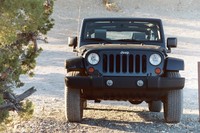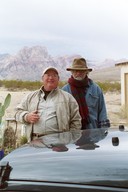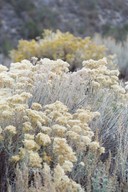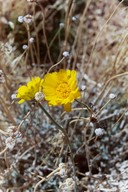A Mojave 4x4 Mystical Tour In A 2007 Jeep Wrangler Sahara Unlimited

2007 Jeep Wrangler Sahara
4x4
|
SEE ALSO: Compare Jeep Models
JEEP WRANGLER UNLIMITED SAHARA 4x4
A Mojave Mystical Tour
By Steve Purdy
The Auto Channel
Detroit Bureau
And With Mojave Moses,
Our Desert Guide
I’m in the rustic old village of Blue Diamond, Nevada surrounded by millions of acres of protected public lands near the center of the
Cottonwood Valley. We’re not far from the popular Red Rock National
Conservation Area. This quiet, serene old mining village hides only about
20 miles from the flash and pizzazz of Las Vegas separated from the city by
Blue Diamond Mountain. None of the usual urban annoyances encroach here -
little traffic, only rare noise, limited ambient night light and no tacky
suburbia. This patch of dusty green in the desert constitutes the base of
operations for our Mojave Mystical Tour. I want to get a sense of why some
people are drawn to this piece of seemingly inhospitable stark desert and
never want to leave.

|
My accomplice and codriver for this tour and exploration is my old pal Mojave Moses, our desert guide. He has been a part of the
desert scene here in this corner of the Mojave for about 25 years and
constantly soaks up, examines and understands the dynamic, fascinating
ecosystems and the distinctive cultures of the area. He has become a
consummate aficionado of all things Mojave. The flora, the fauna, the
geology, the geography and the history, intertwined with the Mojave
cultures and communities, are fodder for his insightful observations. As an
accomplished designer, philosopher and artist Mojave Moses will help us
understand and appreciate the desert.

|
Our ride for the tour is the new Toledo-built 4-door Jeep
Wrangler Sahara Unlimited, on loan from the DaimlerChrysler press fleet.
We’re expecting the Wrangler Unlimited to perform off-road as capably
as the traditional minimalist Wrangler notwithstanding the full back seat
and all those doors. We have the 3.8-liter V6 with a six-speed manual
transmission and two-speed transfer case. The list of standard equipment is
long and impressive: lots of power stuff (windows, locks, mirrors), chassis
controls (4-wheel ABS, electronic stability control, traction control,
electronic roll mitigation), off-road necessaries (lots of skid plates,
heavy-duty suspension with generous travel,

|
shift-on-the-fly 4-wheel-drive,
heavy-duty rear axle), safety equipment (enough air bags, padded roll bars,
and tow hooks to make us at least feel safe), and a bunch of refined
interior elements we didn’t expect in our purposeful off-roader. Base
price with all this stuff is $26,075. Our shiny Steel Blue Metallic test
truck with options has a total MSRP of $30,075. While buyers of most
competent off-roaders seldom, if ever, take them off road I’ll
venture to guess that way more Wrangler owners use theirs purposefully
Somewhere in the neighborhood of 300 people live in the village of Blue
Diamond, most of whom make their living in the city. The majority have come
from somewhere else to settle here. Homes are mostly modest by any
standards but mighty pricey. Why are they so wedded to this place? A Blue
Diamonder named Rick, one of Mojave Moses’ compatriots, said that it
reminded him of “the outskirts of Tijuana on the face of the
moon” when he first passed by. His assessment changed radically. Now,
Rick’s daughter who is headed out into the world to make her fortune
made him promise never to move from Blue Diamond because she wants to
always know that she can come back to this desert paradise if she wants or
needs to. Without hesitation he said, “OK.”
DAY ONE – ROCKY GAP TO MOUNTAIN SPRINGS
As is the routine here at our guide’s home we rise early to watch
the first light of the morning sun illuminate the face of “the
escarpment,” the eastern face of Mt. Wilson, and its neighboring
formations, while having coffee on his gravel and stone patio. On cold
mornings a few sticks of wood go into the chimnea to take the chill off.
One might be shocked at the value of his modest home but his view is
literally priceless. Across the county road from the village is the
mountain and gypsum mine from which the village gets its name. Until
recently the best wall board gypsum in the world came from the Blue Diamond
Mine.
Our first challenge after coffee– and I mean challenge – was
to get the Jeep’s soft top down and stowed. We started out by looking
it over, releasing and unzipping the tethers that were obvious . . . and
there we got stumped. We fiddled and fussed until we finally gave up and
got out the book. To make a long story short, even the book didn’t
help. The directions were convoluted and incomplete. It took us about
45-minutes of trial, error, and rereading the instructions to finally get
it down – but still not down correctly or stowed neatly. We’ll
not even try to get it back up.

|
There’s little chance of rain. The
temperature is cool but not uncomfortable. We’ll just leave the top
down and let the professionals at the press fleet management company put it
back together when I return it in a few days. If you’re contemplating
the purchase of this Jeep, be sure to have a close look, and perhaps a
demonstration of the top system by the dealer. I’d hate to have any
of my dedicated readers be surprised by this awful system after a purchase.
But, maybe we just didn’t do it right

|
At the other end of the Cottonwood Valley from Blue Diamond vivid red
rocks protrude from the earth, probably the only natural feature visitors
to Las Vegas ever see if they’re lucky enough to get out of town at
all. In the back of the Red Rock Park, as the altitude begins to increase,
a little-known dirt road branches off and winds slowly into the canyon then
begins to climb more steeply headed for Rocky Pass. The dirt path quickly
becomes rocky and the rocky path soon becomes a 4-wheeler-only road; and,
the 4-wheeler better be one with lots of ground clearance. Before we knew
it we were in 4-wheel low, first gear bouncing and crawling and clambering
over rocks bigger than our tires and though gullies deeper than the top of
our fenders, skittering across and up rocky washes which have drained this
mountain for tens of thousands of years.
A couple of times I got into second gear-low but mostly had to stay in
first. We stopped periodically to luxuriate in the dramatically higher and
higher views of the valley, the red rocks and the city many miles beyond.
Mojave Moses described the unique geology of the area characterized by
inverted layers of sandstone and limestone. Somehow the older limestone is
above the younger sandstone making for an interesting geological anomaly.
It was so quiet up there we heard only the birds, the breeze and the rustle
of a mountain rodent trying to avoid becoming a morning snack for the
golden eagle. The colors of the layered rock and the fall flora intensified
as the sun moved west. The pervasive smells were of pinion pine, creosote
and juniper – as fresh and clean as Mother Nature can make them. The
only smell better is after a rain when the creosote leaves breathe emitting
the intensive aroma recognized by anyone living in the desert as that
intense after-a-rain smell. Most don’t know it’s the creosote
making that smell. Mojave Moses showed me that on a previous trip
describing the charm of the Mojave.

|
We expect a Jeep Wrangler to be confident and competent in
these demanding conditions, but I must say, I was amazed at the
capabilities of this little full-frame sport-ute: lots of ground clearance,
plenty of suspension travel, good balance, impeccable feedback. We danced
through tougher and tougher terrain. I wondered why we hadn’t
accessed the skid plates yet.

|
We paused for contemplation as we gained the crest at Rocky Gap, at 6,500-feet, where we could see east and west into different
valleys - red rocks to our east and tougher trails to our west. We eased
down the rock path on the other side of the gap and, as expected, the trail
got even more challenging. Just after squeezing between a couple of rocks
higher than the door sill where I had to turn immediately hard left to dive
into a rock mogul keeping enough momentum to get up the next steep incline,
we had to stop for an assessment. We were in a wash of tumbled rocks and
boulders that split into two. Mojave Moses got out and walked a couple
hundred yards down the one we thought would be the right one. Both looked
impassible. He signaled me to c’mon ahead.
I just remember jouncing and bobbing and bucking and twisting through
about a quarter mile of what looked impossible. About a third of the way
through that section I began to rehearse what I might say to the Jeep folks
about why their Jeep was stuck high-centered out in the wilderness or
perhaps how it got to be belly up in the gulley. Fortunately I didn’t
need to use those stories because we got through without a scratch, dent or
bruise to the vehicle or either driver. We did, however, use the skid
plates often on that section as we lurched up onto three wheels a couple of
times, teetering on the edge of disaster. In the category of off-road
competence this Jeep gets an A-plus-plus.

|
Finally down the back of the mountain our adrenalin was
still coursing as we passed through a couple-hundred acres of flowering
meadows - shoulder-high clumps of a half-dozen species of grasses and
shrubs were blooming with complimenary shades of soft white, pale yellow,
rich beige, and dusty red. At least I thought they were meadows because I
could see barely a quarter-mile in each direction. Mojave Moses revealed
that it was actually Lovell Wash, a unique and dynamic ecosystem that leads
about ten miles up into Mt. Charleston, highest peak in the area.
We
traversed that wash just in time to watch the glowing orange sunset from
the ridge overlooking the end of the Pahrump Valley with the Kingston Range
on our left and the Nopah Range to our right. We were looking across the
valley into California. The orange turned to red, then to purple, then to
dark. Wow! In these desert mountains both our sunrise with coffee and our
sunset with adrenalin is way different than anywhere else.
OK. Now I see why the off-roaders love these mountains.
With that challenge met and conquered admirably we headed for the
Mountain Springs Bar - one of the few watering holes still reflecting the
character of the local desert folks - for another lesson in desert culture.
The story of my first and most memorable visit to the dark, musty, dusty,
old Mountain Springs Bar many years ago is one I’ve told many times
and has to do with a ‘gustatory sweat’. In those days Davey,
the owner, cook and bartender, grew his own horseradish and served a
half-cup of it, freshly ground, with every thick, juicy, rare hamburger.
The beads of sweat on my upper lip and forehead attest to the power of the
horseradish. Though Davey is no longer there and the menu is pretty
limited, there are always great people to commune with, as there seems to
be in all these classic desert bars – old friends to be treasured for
Mojave Moses and new friends to be made for us both. A couple there named
Scott and Kim fit into the latter category.
Scott is a beer distributor from Illinois in Vegas for meetings. Kim is
his bubbly, energetic and sexy friend (platonic, they claim – though
that stretches my imagination). It was no surprise to learn that the
effervescent Kim is in high-line sales. They were drawn to the desert this
evening by a desire for something different, perhaps
‘spiritual,’ as opposed to the crassness of the city lights and
city bars. There were only a half dozen of us in this old cowboy bar, so we
were immediately an intimate group. Scott and Kim were enthralled with
Mojave Moses’ knowledge of the desert and his descriptions of some
spiritual sites. So we visited one out back of the bar.
We all clambered into the Jeep in the pitch dark. Since this Jeep has
four doors and decent room in the back it was a breeze. On the first big
bump, though, Kim dumped her entire glass of red wine down my sleeve and
onto the seat. The Jeep’s premium cloth seats wiped perfectly clean,
but my jacket did not.
Behind the bar, about a half-mile up the side of the mountain is a
pristine example of the perfectly round fire pits left behind by the native
people more than a thousand years ago. They gathered here to civilly
discuss inter-tribal issues, and of course eat. We stood in the 5-foot-deep
pit under the sparkling stars as Mojave Moses described, almost as if he
had been there, how the natives cooked agave tips, rabbits and other food
in the pit of heated rocks until the ones on top cracked indicating the
meal was ready. We soaked up the history and marveled at the brightest
stars imaginable, unhindered by ambient light from the city. By the time we
were ready to head back to the bar the half- moon was just above the
surrounding mountains looking as bright as the full-moon looks closer to
the city. It was a spiritual spot, indeed. One that Mojave Moses visits
regularly. One that I’ve explored with him each time I’ve
visited. And it’s a site that amazed and intrigued our attentive and
interested new friends, who are one step closer to becoming desert
people.
DAY TWO – BLUE DIAMOND TO GOOD SPRINGS AND BACK
We missed the sunrise this morning, but we didn’t miss the coffee
klatch at the Blue Diamond market. Like the classic cafés full of farmers
we’d find in small-town Iowa, the veranda of the market in Blue
Diamond attracts local folks who could solve the problems of the world if
only those in charge of the world would listen to them all. A fascinating
mix of fellas along with a mixed pack of a half-dozen of their dogs sniffed
and nudged at one another as a little white one tried to convince the big
ones that he is the alpha mutt. Serious conversation, good natured jiving
and a touch of gossip augmented the coffee and smokes. Then suddenly they
all dissipated as they headed off to meet the day’s demands.
Our goal this day is to cover some more obscure back roads in our quest
for knowledge, insight and serenity. We gather up Mojave Moses friend,
Rick, and explain to him that the reason we’re suffering this
morning’s cold wind in the open vehicle is that we dared not even try
to reassemble the soft top on this Jeep.

|
We took the main road toward Pahrump just a few miles
then slipped onto a barely discernable dirt road toward Good Springs, along
which a variety of look-out points drew us into contemplation. On the right
side of the one-lane dirt and rock road headed southwest was vivid evidence
of “the burn” from about a year ago.Blackened Joshua trees
stand evenly spaced and about five feet high with clumps of light beige
leaves at the end of each gnarled black branch - amazing silhouettes. One
rocky path after another presented itself winding into the foothills.
We bounced up one rough lane that took us to a lookout from which we could see
all the way back to our starting place – back up the Cottonwood
Valley. Again, the desert colors glowed like oils on canvas. Back down to
the main trail a rare yellow wildflower bloomed.

|
Another five miles down the road we turned off onto a trail to the left.
Mojave Moses was at the wheel and he suggested I close my eyes for a bit. I
knew we were approaching a high point in the trail and expected an
overlook, but I didn’t expect one so big. As I felt the nose of the
Jeep tilt forward and down, he came to a stop just before driving off the
cliff and suggested I open my eyes. There before us was the entire Las
Vegas Valley with the City of Sin clearly visible in the center - probably
25 miles away as the hawk flies – looking like a big shallow bowl
with a pile of rice crispies in the middle. Not a sound could we hear
– not a breeze, not a creature, not a motor. The sky was intensely
blue. No smog dirtied the scene - a truly rare day. Here we’ll get a
clearer understanding of our surroundings. We spent a good deal of time
there on a pointy precipice sticking out beyond the cliff. We three
explorers luxuriated in the warm fall sun and the peacefulness of the
scene. We could see the silhouette of a raptor, probably a small eagle,
cruising the base of the cliff. The patterns, colors and textures of the
desert floor below us were like a massive Indian sand painting. Our
meditation was only interrupted by the growling of our stomachs.

|
Back on the rocky, but not difficult, dirt trail it was
only about 10 miles to the rugged little village of Good Springs where
another of those classic desert bars awaited our arrival. Cindy, a tall,
blonde cowgirl, served us lunch at the Pioneer Bar – a frozen
grocery-store pizza and a pitcher of Bud. The rough-cut bar, dating to
around the turn of the last century, looks its age and is clad, ceiling and
walls, with some magnificent old stamped tin panels. A squeaky, well-worn
hardwood floor gives testimony to the natural preservation possible in such
a dry climate. The deeply worn wooden floor reminded me of the erosion of
the surrounding sandstone cliffs. Cindy is a transplanted city girl who
loves living in the little village of Good Springs, a rustic settlement of
little trailers and even smaller, more modest homes than Blue Diamond.
Cindy, too, had a certain serenity we don’t see often in this age of
intensity. A biker who appeared to be spending the day with his elbow bent
over the heavy wood bar reveled in showing us the rare spring suspension on
his Harley parked in the sun outside. A few travelers who happened upon the
bar strode in to take a look and have a chat. A simple newsletter,
distributed from a table near the bar, is Good Springs’ version of a
weekly newspaper.
Even though putting the Jeep’s top down was such a pain in the
tush we’ve been glad it’s down many times in these few days. We
can look out the top as the views become overpowering, and we can perch on
the back seat and stand up through the roof holding on to the padded roll
bars for an entirely new and unique perspective to these drives down the
back roads. On the way back from Good Springs, buzzing down a sandy stretch
of the one lane road, I was standing up holding onto the roll bar poking my
top half out into the 30-mph breeze. The cold air was stimulating as I
looked down upon my fellow travelers in the front seat, both wearing their
Indiana Jones hats, bobbing along the trail. They looked like a pair of
Indiana Jones Bobble Head dolls.

|
We were back in Blue Diamond by late afternoon just in time to join in
at the Tree Bar. In the center of Blue Diamond is the village park. At the
edge of the park, directly across from the market (read, beer store) is the
“Tree Bar,” a rudimentary shelter with a big wood stove in the
center. Chairs and benches are spread haphazardly about. We got back from
our desert drive in time to join the first wave of socializers gathered
around the hot stove chatting, bantering and teasing each other. An unusual
collection of artifacts decorate and define this social space, some with a
crude theme, most with a desert theme. Blue Diamond’s local folks
begin to gather every late afternoon at The Tree Bar – mechanics and
college professors, artists and engineers, adventurers and miscreants -
come and go throughout the evening. Music can burst forth at any time from
any number of the local folks who might play a banjo, guitar, drums,
harmonica, Jews harp – you name it. In all my travels I’ve not
encountered a place as culturally rich as the Tree Bar in Blue Diamond.
And there, my friends, is a hint of the spiritual draw of Blue Diamond
and this corner of the Mojave.
DAY THREE - MYSTICAL INSIGHTS AT THE BONNIE SPRINGS BAR
Our final classic desert bar, at the base of the earlier-described
escarpment, is our breakfast place at Bonnie Springs - a bar, motel,
restaurant, riding stable, and zoo. It’s a rustic old place, as are
all the good ones, and the folks all know and like each other. Like all the
other spots, one must be a “character” to really fit in.
The culture that defines this section of the Mojave desert outside of
the Las Vegas Valley is distinctly different than any place I’ve
explored. We feel that difference on one level at the watering holes we
visited; Mountain Springs Bar, Bonnie Springs, the Pioneer Bar, and of
course the Tree Bar. Similarly similar establishments in Shoshone, Tecopa
and Death Valley Junction we’ve visited on earlier trips welcome
newcomers as if they are family. There is always someone to talk to and
usually those are folks who share a love of this dry land.
Mojave Moses, who spends some of his professional time in
the city, but most in the desert, explains it concisely. In the city where
millions of tourists, business people and miscellaneous revelers pour in
and out every day, people are aloof, cold and uncommunicative, with few
exceptions. Many have never been outside the city except on the freeways or
main roads – and they don’t really care to know what’s
out there.
In the desert nearly everyone is ready to talk to everyone else sharing
experiences of nature, history, adventure and culture. In Mojave
Moses’ village of Blue Diamond, a community of modest, unpretentious
homes there must be dozens of serious rock climbers, off-road adventurers,
mountain bikers, dune buggiers, serious conservationists and all around
desert lovers - in other words, those who are intimately connected to the
land, to the ecology and this unusual culture. Many have artistic talent
and interests and nearly all have a well-developed aesthetic sense.
We started out to do a road test evaluation of the Jeep
Wrangler Unlimited with a mystical tour of the Mojave as the theme. Our
project turned out to be an insightful education on the Mojave Desert and
its people. We now have a better understanding of both. This Jeep is an
admirable off-road tool of exploration and enlightenment. This part of the
Mojave is a wonder place to explore.
Watch for upcoming explorations of Death Valley, the Amargosa and some
other great locations with other good off-road rides with our friend,
Mojave Moses.
© Steve Purdy, Shunpiker Productions, All Rights Reserved



















